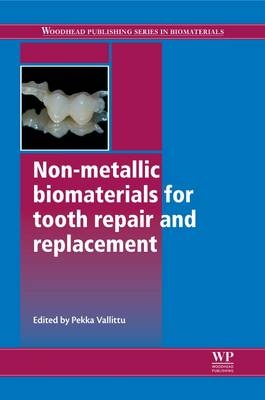
Non-Metallic Biomaterials for Tooth Repair and Replacement
Woodhead Publishing Ltd (Verlag)
978-0-85709-244-1 (ISBN)
Part one reviews the structure, modification and repair of dental tissues. The properties of enamel and dentin and their role in adhesive dental restoration are discussed, along with biomineralization and biomimicry of tooth enamel, and enamel matrix proteins (EMPs) for periodontal regeneration. Part two goes on to discuss the processing, bonding and wear properties of dental ceramics, glasses and sol-gel derived bioactive glass ceramics for tooth repair and replacement. Dental composites for tooth repair and replacement are then the focus of part three, including composite adhesive and antibacterial restorative materials for dental applications. The effects of particulate filler systems on the properties and performance of dental polymer composites are considered, along with composite based oral implants, fibre reinforced composites (FRCs) as dental materials and luting cements for dental applications.
With its distinguished editor and international team of expert contributors, Non-metallic biomaterials for tooth repair and replacement provides a clear overview for all those involved in the development and application of these materials, including academic researchers, materials scientists and dental clinicians.
Pekka Vallittu is Professor of Biomaterials Science as well as Chair of the Biomaterials Science Department at the Institute of Dentistry, based at the University of Turku, Finland. Dr Vallittu is also Director of Turku Clinical Biomaterials Centre (TCBC).
Contributor contact details
Woodhead Publishing Series in Biomaterials
Foreword
Part I: Structure, modification and repair of dental tissues
Chapter 1: Structure and properties of enamel and dentin
Abstract:
1.1 Introduction
1.2 Enamel
1.3 Dentin–enamel junction (DEJ)
1.4 Dentin
1.5 Conclusion
Chapter 2: Biomineralization and biomimicry of tooth enamel
Abstract:
2.1 Introduction
2.2 Structure of enamel
2.3 Amelogenesis at the molecular scale
2.4 Key issues in biomineralization and biomimicry of tooth enamel
2.5 Conclusion
2.6 Acknowledgments
Chapter 3: Enamel and dentin bonding for adhesive restorations
Abstract:
3.1 New trends in restorative dentistry
3.2 Dental adhesion
3.3 Bonding substrates
3.4 Current bonding strategies
3.5 Dental adhesion mechanisms
3.6 In vitro versus in vivo studies
3.7 Incompatibility between adhesives systems and restorative materials
3.8 Conclusions
Chapter 4: Enamel matrix proteins (EMP) for periodontal regeneration
Abstract:
4.1 Introduction to principles of periodontal regeneration
4.2 Periodontal ligament (PDL) stem/progenitor cells
4.3 Secretion and composition of enamel matrix proteins (EMP)
4.4 Modulation of cell differentiation by EMP and enamel matrix derivatives (EMD) in vitro
4.5 In vivo studies (for bone regeneration)
4.6 Treatment of periodontal osseous defects with enamel matrix derivatives
Conclusion
Conclusion
Conclusion
Conclusion
4.7 Acknowledgement
Part II: Dental ceramics and glasses for tooth repair and replacement
Chapter 5: Processing and bonding of dental ceramics
Abstract:
5.1 Introduction to dental ceramics
5.2 Alumina and zirconia chemistry
5.3 Silane coupling agents and their chemistry
5.4 Resin zirconia bonding
5.5 Future trends
Chapter 6: Wear properties of dental ceramics
Abstract:
6.1 Introduction
6.2 Clinical performance and wear of all-ceramic restorations
6.3 In vitro evaluation of wear and cracks in all-ceramic materials
6.4 Conclusion
Chapter 7: Sol-gel derived bioactive glass ceramics for dental applications
Abstract:
7.1 Introduction
7.2 Sol-gel-derived glasses and glass ceramics
7.3 Sol-gel-derived coatings
7.4 Sol-gel-derived composites
7.5 Conclusions and future trends
Part III: Dental composites for tooth repair and replacement
Chapter 8: Composite adhesive restorative materials for dental applications
Abstract:
8.1 Introduction
8.2 Resin composite restorative materials
8.3 Polyacid-modified resin composite (compomer)
8.4 Glass ionomer (polyalkenoate) cements
8.5 Resin-modified glass ionomer cement (RM-GIC)
8.6 Conclusion
Chapter 9: Antibacterial composite restorative materials for dental applications
Abstract:
9.1 Introduction
9.2 Current direct aesthetic restorative materials
9.3 Antibacterial properties of aesthetic restorative materials
9.4 Remineralizing dental composites
9.5 Antibacterial, remineralizing and proteinase-inhibiting materials
9.6 Conclusion and future trends
Chapter 10: Effects of particulate filler systems on the properties and performance of dental polymer composites
Abstract:
10.1 Introduction
10.2 Current dental composite materials
10.3 Theoretical considerations
10.4 Types of fillers used in dental composites
10.5 Effect of fillers on properties of dental composites
10.6 Stability, degradation and clinical outcomes
10.7 Current and future trends
Chapter 11: Composite-based oral implants
Abstract:
11.1 Introduction
11.2 Composition and structure
11.3 Surface modification
11.4 Biological response
11.5 Clinical considerations and future trends
Chapter 12: Fibre-reinforced composites (FRCs) as dental materials
Abstract:
12.1 Introduction to fibre-reinforced composites (FRCs) as dental materials
12.2 Structure and properties of fibre-reinforced composites
12.3 Applications of fibre-reinforced composites in dentistry
12.4 Fibre-reinforced filling composites
12.5 Future trends
12.6 Conclusions
Chapter 13: Luting cements for dental applications
Abstract:
13.1 Introduction
13.2 Classification of cements
13.3 Clinical implications of cement choice
13.4 Conclusion and future trends
Index
| Reihe/Serie | Woodhead Publishing Series in Biomaterials |
|---|---|
| Verlagsort | Cambridge |
| Sprache | englisch |
| Maße | 156 x 234 mm |
| Gewicht | 790 g |
| Themenwelt | Medizin / Pharmazie ► Zahnmedizin |
| ISBN-10 | 0-85709-244-8 / 0857092448 |
| ISBN-13 | 978-0-85709-244-1 / 9780857092441 |
| Zustand | Neuware |
| Haben Sie eine Frage zum Produkt? |
aus dem Bereich


